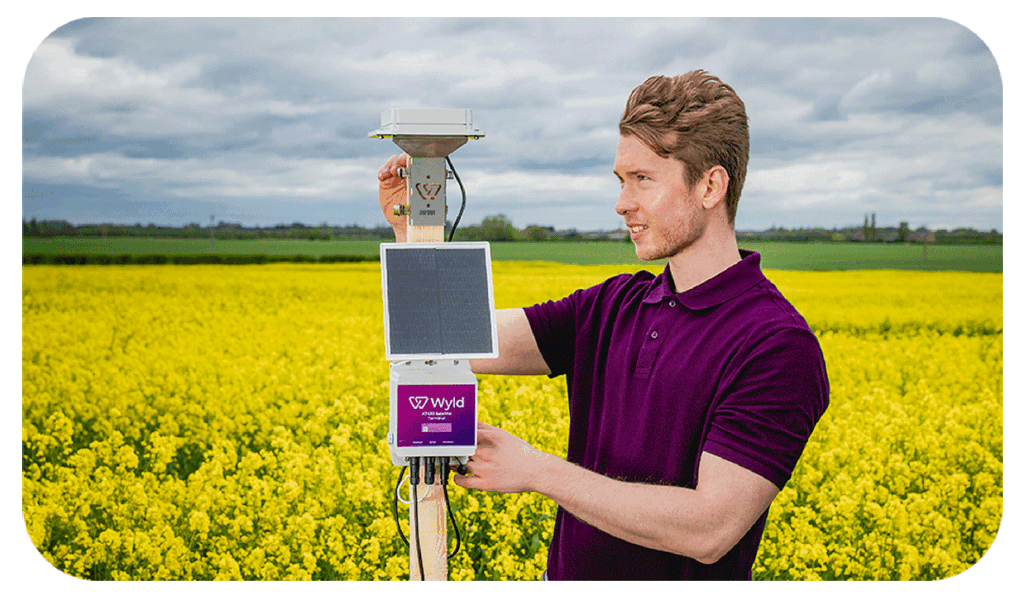In today’s era of climate uncertainty and rising global food demand, efficient water management is one of agriculture’s most critical challenges. Soil moisture sensing — especially in remote or off-grid areas — is becoming indispensable. Powered by satellite-connected IoT solutions, this technology is helping farmers make smarter irrigation decisions, conserve water, and boost crop yields.
Let’s explore how satellite IoT is revolutionizing soil monitoring, the growing global market for these technologies, and a standout case study featuring Wyld Networks, KWS, and DFM Technologies.
📈 Global Soil Moisture Sensing Market: Growing Fast
The global soil moisture sensor market was valued at approximately USD 371 million in 2023 and is projected to reach USD 940.5 million by 2030, growing at a CAGR of 14.7%. This growth is fueled by the need for precision agriculture, improved irrigation efficiency, and sustainable farming practices.
Soil moisture sensors help:
- Optimize irrigation schedules
- Reduce water and energy consumption
- Improve plant health and yield consistency
However, to fully realize these benefits in rural or infrastructure-poor regions, connectivity is key — and this is where satellite IoT plays a vital role.
📡 Why Satellite IoT?
In many remote farming locations, traditional cellular networks are either unreliable or non-existent. Satellite IoT bridges this gap by providing direct-to-satellite communication for sensors across the globe.
Solutions like Wyld Connect and RockBLOCK offer global coverage through LEO satellite constellations, providing:
- Data transmission from anywhere
- Low power consumption ideal for field devices
- Seamless integration with existing agronomic platforms
🌾 Crops That Benefit from Soil Moisture Monitoring
Soil moisture data benefits virtually all major crops, but especially those with high sensitivity to water availability:
- Corn: Moisture monitoring helps optimize irrigation during key growth stages for yield gains.
- Potatoes: Sensors reduce overwatering, a major contributor to disease and crop loss.
- Soybeans: Efficient water use improves root development and reduces fertilizer waste.
- Sugar Beets & Oilseeds: Monitoring ensures soil conditions are optimal for these water-intensive crops.

💰 ROI: From Irrigation to Yield Gains
Soil moisture sensors connected via satellite offer clear return on investment:
- 🌊 Up to 66% reduction in water usage by avoiding unnecessary irrigation.
- 🌾 10–25% yield improvement with precision water delivery.
- 💡 8:1 ROI ratios observed in root crops like potatoes when smart irrigation systems are employed.
These numbers are especially impactful in regions facing water scarcity or regulatory pressure to reduce runoff and chemical use.
🛰️ Case Study: KWS, Wyld Networks & DFM Technologies
One of the most compelling applications of satellite IoT for soil moisture sensing comes from KWS, the world’s fourth-largest seed producer.
🔬 The Challenge
KWS conducts extensive seed trials across Europe — particularly in France and Italy — in areas where cellular connectivity is limited. These trials rely heavily on accurate, continuous data on soil moisture and temperature at multiple depths to evaluate seed performance and optimize irrigation strategies.
🔗 The Solution
KWS partnered with Wyld Networks and DFM Technologies to deploy a complete satellite IoT soil sensing solution:
- DFM Soil Probes measure moisture and temperature at up to six depths, providing granular soil insights.
- Wyld Connect Terminals transmit data directly to LEO satellites over ISM, L-band, and S-band frequencies.
- Data is integrated through the Wyld Fusion platform and fed into KWS’s analytics tools.

🚀 Results & Benefits
- Reliable regular data from remote fields
- Reduced crop stress and better irrigation timing
- Enhanced R&D by improving the precision of seed trials
- Environmental gains through reduced water and fertilizer usage
KWS is in the process of scaling the solution globally, using this setup to support more seed trials in diverse and disconnected environments benefitting from the reduced need to support and deploy terrestrial IoT infrastructure such as gateways and relays.
🔮 The Future of Satellite Soil Monitoring
As agriculture evolves to meet the twin demands of productivity and sustainability, satellite IoT is becoming a core enabler of next-gen farming. Whether for large agribusinesses like KWS or smaller operations in remote regions, connected soil monitoring will play a pivotal role in:
- Boosting global food security
- Reducing agriculture’s environmental footprint
- Supporting data-driven decision-making on every hectare
For more stories and solutions at the intersection of space, sensors, and soil, stay tuned to satelliteiot.space — where the future of precision agriculture is always within reach.